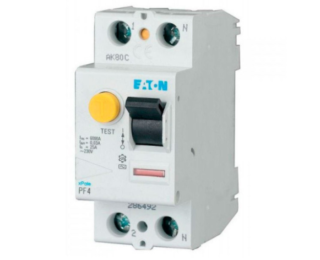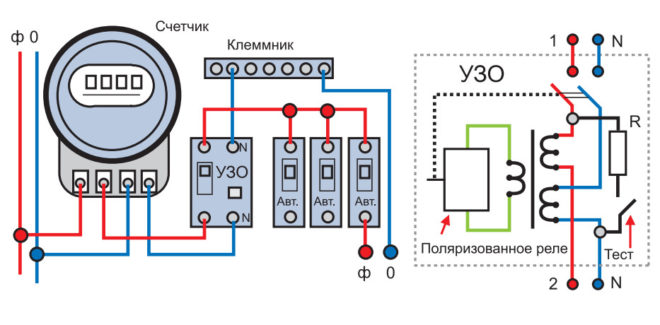RCD is a residual current device. It is a special device that, in the event of insulation breakdowns, removes the voltage in the circuit to which it is connected in order to prevent current leakage. To connect an RCD without grounding in an apartment, you need to understand the principles of the system.
What is the need to install an RCD

RCD is a necessary measure to protect living beings from the negative effects of electric current. Also, the device prevents the fire of electrical wiring in the event of its mechanical faults.
Electrical circuitry can be damaged for a number of reasons:
- under the influence of high temperatures;
- due to physical deterioration of the insulation;
- with external mechanical interference and violation of the integrity of the circuit.
If there is no RCD connection, human contact with damaged electrical wiring can lead to serious consequences, including death. Also, in the absence of the owner in the room, a fire may start. Wood structures, which are highly flammable, are especially dangerous.
How does an RCD with and without grounding work?
Without grounding, if the insulation is damaged, a dangerous potential arises on the housing of the device. The risk is that the controller's protection mechanism will not be triggered, as the circuit does not provide a current output.
Upon contact with a person or other living creature (for example, a pet), the current leakage will pass through his body towards the ground - it will find grounding. The current will flow through the human body until its value corresponds to the threshold value at which the protective device is triggered. Only then will the circuit turn off and the power will stop flowing. The duration of the negative impact depends on the values at which the control mechanism is triggered.
In general cases, the process lasts no more than a minute, however, a couple of seconds may be enough for a person to receive serious injuries.
If the RCD is connected to ground, the circuit will trip immediately when there is a positive difference between the input and the output. Therefore, a dangerous potential does not arise on the device case, and the excess current goes into the ground, without having any effect on a person.
Operating principle
In the circuit, the device acts as the main controller of the current strength, which enters and exits it, respectively. With a non-zero difference, a leak is detected, a signal about which is sent to the RCD and in less than a second the electrical circuit is turned off.
In a stable and healthy network, there is no noticeable difference between the input and output voltage, so the controller does not work and all connected equipment works normally. In emergency situations with a leakage of current, the entire electrical network stops working, preventing ignition or direct contact with a person.The principle of operation is primarily aimed at safety, therefore, the RCD does not react in any way to emergency situations that are not accompanied by current leaks, for example, to an overload of the electrical network or a short circuit in it.
How to connect an RCD if there is no grounding
The practical implementation of the method that excludes grounding occurs according to the following algorithm:
- The electricity goes out.
- The RCD is fixed on the DIN rail using special latches.
- First, the input terminal is connected, then the neutral wire. The corresponding markings can be found on the instrument housings.
- Phase output is distributed to all machines.
- The output of the N contact is connected to the zero bus.
- The introductory machine turns on, and the circuit is checked for correct connections.
When you press the test button, the RCD should turn off. If there is a problem with the device itself or the commutations are connected incorrectly, this does not happen.
Scheme options
Before connecting an RCD without grounding, make sure that standard machines are present in the circuit. It is connected in two ways:
- at the entrance;
- to the entrance and to the branching branches.
It is important that the device is only connected in combination with a circuit breaker, otherwise it will not perform its function.
Input connection
This option implies the inclusion of the device in a general circuit to protect all home wiring. For this method, it is necessary to connect RCDs and outgoing connections.
Significant savings can be identified from the advantages of the input connection scheme, since only one controller is used to ensure safety. However, there are also disadvantages at the same time. For example, when a phase is closed on one device, the entire electrical network fails and the voltage supply to all connected equipment in the apartment is cut off.

Before choosing this option, it is advisable to weigh the pros and cons of this method of operating the device. The circuit is suitable for connecting an RCD in a single-phase system without grounding.
Connection upstream and downstream
To implement this scheme, you will need several RCDs in a two-wire network. As in the previous version, one of them is installed at the entrance after the input automatic machine, and the rest are placed immediately after the circuit breakers of the outgoing connections.

The number of devices required depends on the grouping and scheme of the home electrical network. Most often, they use the division into lighting and outlet sources. Sometimes a method is used to separately protect expensive and energy-consuming equipment that consumes electricity. In this case, the installation of an RCD in a two-wire network without grounding is ideal.
Mistakes to Avoid
Often, when self-installing an RCD in a house without grounding, errors are made:
- neutral and ground are included in the circuit after the protection device;
- the connection is incomplete;
- neutral and grounding conductors are connected;
- two RCDs are connected by combining zeros;
- polarity is not respected.
To avoid mistakes, it is advisable to involve professional electricians in the installation. Also, after connecting, it is imperative to carry out a test run by pressing the corresponding button on the device.










Wrong information from the author!
The article contains errors, namely:
It will be correct - the RCD is connected in two ways:
- at the entrance;
- or to the outgoing branches (groups).
Scheme-picture - "Connection to the input" - According to the PUE, the input voltage is supplied to the switching devices from the top, and not from the bottom, as in the diagram-picture! If you try to apply the input voltage to the RCD from the bottom (to the output), then it will not work, or it will fail.
Scheme-picture: "Connection at the input and at the outgoing branches" - an RCD is installed either in a single quantity at the input, as the main protective device, or on outgoing groups, but at the same time, the input RCD is not installed, but an AUTOMATOR is installed to protect against a short short circuit, and overload, or a combined RCD with a built-in automatic device.
As an author of this article, first learn the basics of electrical engineering and the Regulations before misleading people with information.
Comrade from the USSR, time does not stand still :-) ... Right now I looked at the passport of the Legrand RCD of the 4020xx - 4030xx series, and there in the picture it is allowed to connect the input both from the top and from the bottom. However, on ABB machines - the same picture, it is possible from above, and from below, probably from the side, if you turn it to one side ...